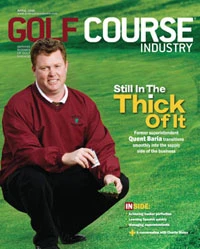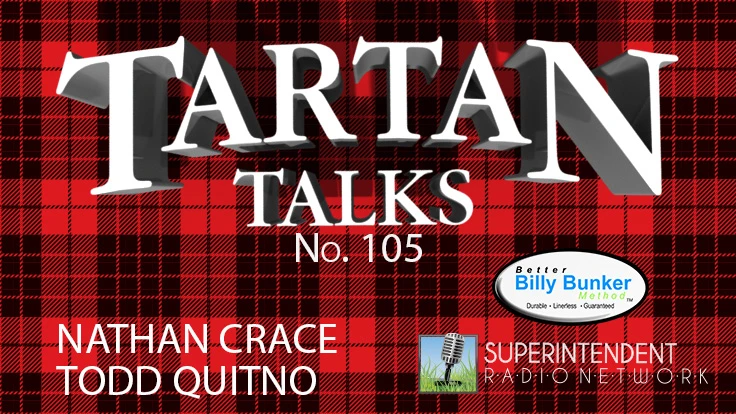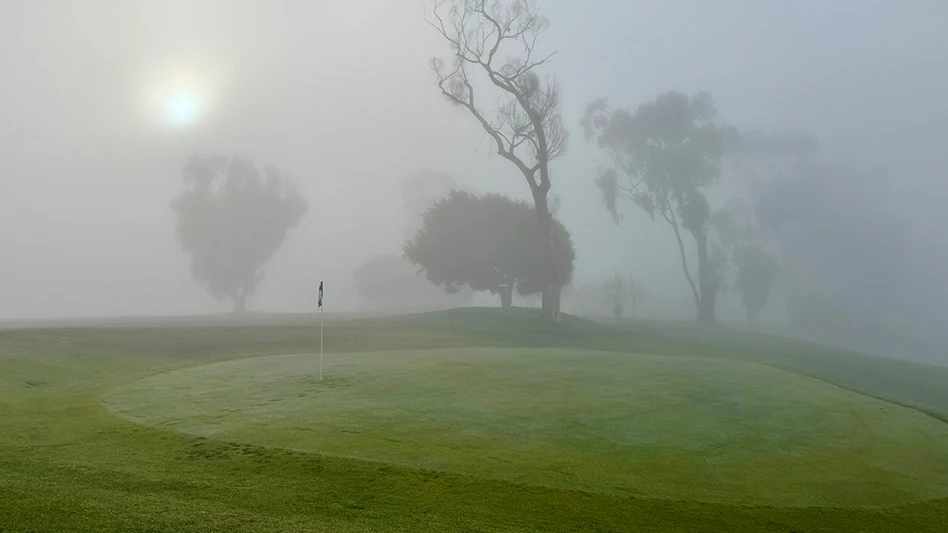Last year, after 19 years as a superintendent and a lifetime on golf courses, a middle-aged Quent Baria, CGCS, found himself looking for a job. After a career progression with four different clubs on the East Coast, Baria’s hand was forced at the Towson Golf and Country Club in Phoenix, Md. Instead of looking for another superintendent job, he already was contemplating working for a chemical company. Now a territory manager for Valent Professional Products, his transition from superintendent to salesman has been smooth.
Baria’s story is similar to many other superintendents who’ve left the profession but not the industry because they’ve taken jobs helping out their brethren on the supply side of the business.
From cradle to grass
Like many, Baria was born into the profession. His father, Robert E. Baria Jr., was a golf course superintendent, so the younger Baria grew up on a golf course, the Fincastle Country Club in Bluefield, Va., and lived on the property.
“I lived there since I was an infant, from the first day my folks brought me back from the hospital,” Baria says. “I decided early on, at the age of 16 or 17, that I wanted to pursue turf management as a career.”
After high school, Baria attended Virginia Tech and earned a Bachelor of Science degree in agronomy specializing in turfgrass management. After graduation, he spent one year as an assistant superintendent at the 27-hole Glen Oaks Club in Old Westbury, N.Y., under superintendent Richie Struss, CGCS, who’s still there.
At Glen Oaks, Baria learned the colloquialisms and regional differences of turf management. He also was exposed to how a high-end club operated, and he took in the management feel.
“Basically, I saw the nuts and bolts of dealing with members,” he says. “Richie was more of a liaison to the membership. I was basically his man on the ground to accomplish missions. He was under a different set of pressures and circumstances. I learned there’s another side to being a golf course superintendent.”
Baria also learned a lot from his father, who always set the bar extremely high. The elder Baria, who has been a GCSAA member for 45 years, retired from the profession at age 59 because of health reasons.
“While on his crew, I took the heat for a lot of things I didn’t do just so he could get the message across to other crew members,” he says. “He was a perfectionist. Even though there were membership demands, they weren’t as demanding as the ones my father put on himself.”
Top dog
In 1989, Baria left Glen Oaks and came back to southwestern Virginia, to his roots, and took the head superintendent job at the Tazewell Country Club in Pounding Mill, Va., at the young age of 23. Baria’s original plan, however, was to spend another year or two as an assistant at Glen Oaks. But because there was a job opening 20 miles from his home and the folks at Tazewell sought him out to fill the position, he took it.
“That was back in the golf building phase when the demand for superintendents was high,” he says. “It was unlike a lot of the assistants nowadays who are five to 10 years in that role. I was fairly green but not as green as many of the young superintendents because of my experiences with my father and having worked on a golf course since I was 14 years old. I had nine years of experience on a course, obviously not in management, when I took the job at Tazewell, where I spent about five years.”
At the time, Tazewell was one of the lower-tier private clubs that had budget and playability issues. The course lost a significant portion of grass on the greens the season before. One green was completely out of play and considerable portions of eight greens were out of play because of turf loss. Baria started early in the spring working to recover the turf, which was a bentgrass/Poa annua mix. He was able to regrass and reclaim a large portion.
“I started that job April 2, and after Memorial Day, we were 100 percent grass from then on every year,” he says. “We were off to a rocket start, and the members were happy. They were saying, ‘This guy can grow grass on a rock.’”
Baria credits his success at Tazewell to his skill set, which the club hadn’t been able to hire before.
“There were far fewer turf professionals, far fewer people educated on a college level in rural southwestern Virginia,” he says. “The ones that were around didn’t seem to make their way into that part of the world.”
As Baria reflects back on his career and some of his greatest successes, he thinks of Tazewell.
“It’s a mark of true leadership when you can go back to a facility and not see where they missed you but see where they grew with you and continued to grow,” he says. “You set a pattern, and they continued to grow even after your departure. It’s neat to know you’ve been a part of that. I got the ball rolling, and from that day, they continued to function as a debt-free club. They paid for projects, such as irrigation upgrades, with cash. They’ve managed effectively and wisely. They’ve continued to seek professionals after I left. I felt like they got their money’s worth when they hired their first professional.”
Deep roots
From Tazewell, Baria moved on to Fincastle in 1993 to take the place of his father after his retirement. But before he left Tazewell, he had input on the superintendent that followed him – Charlie Scott.
“Tazewell is an intermediate-tier private club, one of those where a superintendent will come and stay four or five years,” Baria says. “It’s not that kind of perch position where you try to end your career, but it has had quality people and results ever since I was there.”
Fincastle was stable when Baria started working there, but later, because of a lack of clarity, the club went through with an untimely expansion and clubhouse renovation and invested a lot in phases of the operation that were destined not to produce a return on investment, Baria says. Although he had an opinion, Baria says it wasn’t his place to offer his input about such investments.
“It was already a line of demarcation and a source of division among the membership,” he says. “I made a conscious decision early on and stayed away from that one.”
Baria says the club believed it could improve its food-and-beverage, catering and facilities management and turn those improvements into a source of revenue rather than a drain.
“They actually increased the size of the monster they needed to feed, and that didn’t turn out to be a good thing,” he says. “But hindsight is 20/20.”
While at Tazewell, Baria’s budget was about $150,000, which equates to about $300,000 nowadays. At Fincastle, the budget was about $375,000, which equates to about $750,000 now. With those budgets, he was able to stay current with industry trends, such as using soluble spray programs, flat-line growth curves on greens, plant growth regulators to manage ball roll and mowing intermediate roughs. He also implemented a three-year sizable landscape plan for Fincastle’s entire facility.
“Rather than just sit down there in isolated southwestern Virginia and let the world pass us by, we were keeping pace with all the trends and improvements that were going on in the industry,” he says. “What was always neat in that climate and region was that our membership could go elsewhere to some of the finest venues, whether it was at the Greenbrier or destination beach resorts, and come back home and say, ‘You know what, we get to play a better golf course at home than we do when we leave.’ That type of statement made you proud.”
Aside from agronomic issues, Baria also developed his business management acumen at Tazewell and Fincastle. He had the pleasure of working with Walter (Buck) Sowers, a successful businessman and green chairman at Fincastle.
“I quietly requested he take over the role as green chairman because I worked with him before,” he says. “He had been my father’s green chairman for a number of years. He recognized right away that he couldn’t make me a better technician, but he could make me a better manager. The first thing he did was hand me the book, ‘The Goal,’ by Eli Goldratt and said, ‘This book doesn’t have anything to do with turf management, but it has a lot to do with ongoing improvement.’ It helped me to make sure we had systems in place and that we get correct feedback and act correctly on that feedback to make sure the next time we go through a process, procedure or budget, we were better at it the second, third and fourth time around.”
Time at Towson
Baria’s next career move came in 2002, when he left Fincastle to go to Towson.
“After a while, the budget at Fincastle flatlined, and without malice or discontent on any party, I surmised that, from a career standpoint, we had gotten to a plateau level where I wasn’t going any farther,” he says.
Baria was looking actively for another job during the last year at Fincastle because he didn’t want to make a hurried decision. Baria was attracted to Towson for several reasons: working with a budget that was double the size of Fincastle’s, working in a metropolitan region and being compensated more.
“The dynamic was pretty neat at Towson,” he says. “It was all about comparing favorably to your peer and sister clubs around the Baltimore beltway. If you didn’t compare favorably, the pressure was on. If you were in a position in which you compared favorably, you could ride the wave.”
Moving from a rural setting to a metropolitan one allowed Baria to be recognized by more of his peers.
“A few people in the industry had always recognized that I was doing innovative things and using leading technologies,” he says. “That started to be recognized by a larger set of people when I moved to Towson.”
One of the innovative strategies was rebuilding all 19 greens using the International Greens Method with the help of Joe Harmon of Harmon Turf Services. The project was done out of necessity. (For more, see the article, “The international way,” on page 13 of the May 2007 issue.) Reflecting on the project, Baria says it was one of his most successful communication efforts as a superintendent.
“We went from crisis management mode and morphed so quickly into project management mode,” he says. “I worked with a great set of club leaders. The golf professional, Mike Welsh, and his staff and their confidence in me never wavered. We kept moving forward, and 12 weeks later, we were playing on 19 new greens.”
Baria also implemented innovative stategies with labor, staffing and scheduling at Towson. He had a 26-person staff, and at the height of the program, 17 of those people were part-time retirees.
“It was the way I met a unique challenge, not that it hadn’t been tried before, but I probably took it to the next level, where those retirees actually became the core of my crew,” he says.
A budding relationship
The birth of Baria’s relationship with Valent started with his strategies to reduce Poa populations in the bentgrass fairways at Towson. He was interested in the herbicide Velocity.
“Velocity was the first true herbicide that you could use in season with predictable results,” he says. “The only other herbicide that was really available was ethofumesate, which was used at the end of the season. With ethofumesate, the efficacy of the product was pretty much at the mercy of how severe your winter was. The other products used to control Poa were growth regulators, which are effective tools to harness levels of infestation, but they’re not herbicides.”
When Baria arrived at Towson, the mid-Atlantic superintendents welcomed him to the area, enabling him to rapidly interface and exchange ideas with them. One such peer was Dean Graves, CGCS, at the Chevy Chase Club in Maryland. Graves was using Velocity as an experimental product on bentgrass fairways. Baria saw some of the results while Graves was using the product, so he had visual feedback and knew what to expect when he began using the product. Then he started working with the folks at Valent and experimented on his own to see what worked best at Towson. Eventually, Baria began working with the company as a cooperator to test Velocity.
“I was buying and using the product from year one, but I had a knowledge and experience base from basically observing Dean, who was gracious enough to let me do so,” he says.
Career change
Dealing with members and committees is another aspect of the job Baria learned from his father. Though the GCSAA was helpful, too.
“We are able to take seminars about ‘managing up,’ which is a buzzword about educating the people and decision-makers above us,” he says. “I tried to use all the resources at my disposal to make sure I continued to mature.”
While “managing up,” Baria was effective with certain people and less effective with others.
“That doesn’t mean we shouldn’t try to work harder when we see the feedback isn’t what we hoped it would be,” he says. “You have to learn to work with all types of people throughout various levels of the club, some more teachable and manageable than others. In all candor, I grew a bit frustrated with my ineffectivness and as a result became interested in opportunities with Valent.”
In the spring of 2007, Baria asked himself how much longer he was going to be a golf course superintendent.
“I’d been going to a couple of retirement parties for superintendents,” he says. “They were guys much like me who changed gears and went other ways. I was put on the spot by Rhys Arthur, GCGS. (He ran a 36-hole facility named Indian Spring in Rockville, Md. Course owners sold the land for development, and that was when he exited the business.) As I was exiting one of those get-togethers, he asked how long was it going to be before I hung it up. I said I didn’t think I was finished yet. He looked me dead in the eye and said, ‘You have no idea how much pressure you’re under.’ I said, ‘I’ve got some idea.’ He told me I’d like the sales side of the business, and that put an indelible image in my brain. It caused me to think about it and have conversations with my wife, Theresa.”
After the encounter with Arthur, Baria formulated an exit strategy from Towson, but he thought he wasn’t finished growing grass just yet. At the same time, he was working closely with Valent, testing and using more of the company’s new pesticides regularly. Jerry Bunting, a territory manager, called Baria to let him know the company was in need of more managers.
“I must admit, I wasn’t initially attracted to the day-to-day calling on end-users, but the educational aspect of working with distributors was attractive,” he says. “I probably wasn’t going to see another opportunity like this in a long while.”
Baria didn’t openly tell Bunting he was looking for a career change, but he figured Bunting picked up on some of the frustration he was dealing with: people on the green committee and underfunded expectations.
But shortly before Baria was about to make his move to Valent, he was fired from Towson.
“The club was unhappy with me,” he says. “As a superintendent, you have a shelf life at a club. Relationships grow old and stale. With the rotations of green committee members and boards, you deal with people in charge you’re not effective with.
“But what always trumps changing jobs is your financial responsibilities and obligations to your family, which doesn’t allow you to just leave a job whenever you want,” he adds. “You often have to put up with the low satisfaction of a job for a while.”
Every job contract signed by a superintendent is signed under duress, Baria says. That’s because if a superintendent doesn’t sign a contract, he’s on the sideline without income or a job, and getting back in to the game from the sideline isn’t a good position to be in.
“I had a contract with Towson, and there was a clause in it that stated either party can terminate it in 30 days at any time,” he says. “But if you don’t sign the contract, there are plenty of other superintendents or assistants right behind you who will sign it.”
Before taking the Valent job, Baria consulted with Mark Merrick, CGCS, who formerly worked at The Elkridge Club in Baltimore. Merrick had made a similar move to Syngenta.
“I talked to him about the transition and conferred with him, which reinforced that I was making the right decision,” Baria says.
Meeting needs
Baria’s first order of business with Valent was attending an annual sales meeting. Right away he could tell his new career in sales was going to be far different from life as a superintendent.
“With the brainpower in the room – among the sales, field research, development, marketing and business administration teams – I quickly realized one of the challenges of my new job wasn’t going to be the traditional ‘managing up’ I had done in previous positions but learning from my new resource group and turning their wealth of knowledge and experiences into my success.”
Baria went through extensive presentation training for use at future sales meetings, as well as new employee, sales and technical training.
“Whether it’s setting up a new distributor, fielding technical questions, sharing my experiences with superintendents or giving a training seminar to a distribution sales team, I’m thoroughly enjoying my new responsibilities,” Baria says. “We’re in the people business. Sales happen when you take care of people by meeting their needs.” GCI
 | Garden Center is adjusting the way the 2025 Top 100 Independent Garden Centers List is built. This year, for the first time, we are asking all retailers to report annual revenue for *only* their top-performing or flagship location. Submit your IGC for consideration on the list today.
|

Explore the April 2008 Issue
Check out more from this issue and find your next story to read.
Latest from Golf Course Industry
- Beyond the Page 65: New faces on the back page
- From the publisher’s pen: New? No way!
- Indiana course upgrades range with synthetic ‘bunkers’
- Monterey Peninsula CC Shore Course renovation almost finished
- KemperSports and Touchstone Golf announce partnership
- PBI-Gordon Company hires marketing manager Jared Hoyle
- Mountain Sky Guest Ranch announces bunker enhancement project
- GCSAA names Joshua Tapp director of environmental programs







